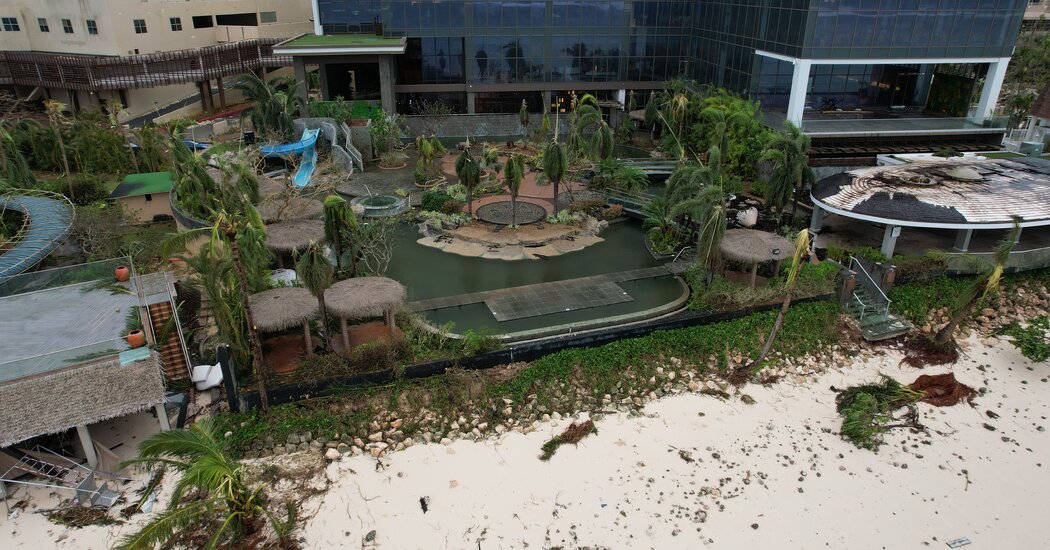Global Courant
Thousands of people on the island of Guam were without power, water and cellphones on Friday, more than a week after the US territory was battered by the strongest typhoon in at least two decades, which flooded homes, knocked down coconut and mango trees and disrupted basic services.
“Losing water was the hardest part,” said Melinda Sanchez, 50, whose family lives in central Guam. Still, she said, islanders were familiar with storm-related disruptions. “We are just going back to what we have learned in these times. We will get through it.”
The typhoon, Mawar, produced widespread flooding and winds of 140 miles per hour, equivalent to a Category 4 hurricane, when it struck the Pacific island of 150,000 people on May 24, causing the current to spread across much of the territory was turned off. Now a tropical storm, Mawar forced the evacuation of 1.2 million people as it approached Japan on Friday.
No deaths have been reported on Guam, which is home to bases for the US Navy and Air Force, but officials said restoration of basic services could take several weeks in some parts of the island.
The Guam Power Authority said in a update on Friday that electricity had been restored to just over 40 percent of customers, while the Guam Waterworks Authority reported that about half of the wells that supply most of the island’s water were operational. About half of the island’s cell phone towers were working Thursday, officials said.
President Biden declared a major disaster for the area after Mawar, allowing residents to do so to apply for individual assistance from the Federal Emergency Management Agency. Hundreds of federal aid workers are on the island to support recovery efforts, the agency said, with help from the military, including the US Army Corps of Engineers.
The governor of the area, Lou Leon Guerrero, said on Facebook that the disruption to the island’s communications systems had made recovery efforts more challenging, but that in the week following the storm, “we have already made significant improvements to damaged infrastructure and restored critical public services.”
Yet Jesse Alig, mayor of the village of Piti and the president of Guam’s mayoral council, said Tuesday in an emergency session of the area’s legislature criticism of the response of the island’s government and utilities, called it slow and inadequate.
“We should be ashamed that we made our people suffer,” the mayor said, adding, “Mawar was nothing compared to what we are going through now.”
Nearly the size of Chicago and about 1,500 miles east of the Philippines, Guam is accustomed to typhoons (as tropical cyclones are called in the Pacific; in the Atlantic they are hurricanes). The last major storm, Typhoon Pongsona, made landfall in 2002 with a Category 4 magnitude and caused more than $700 million in damage.
In an early estimate after Mawar struck last week, government officials estimated the island’s commercial sector had lost about $112 million, mostly due to damage to buildings. A broader assessment of the storm’s impact awaited the restoration of communications and other services.
The island’s main medical center, Guam Memorial Hospital, was forced to rely on generators in the immediate aftermath of the storm, but has since restored power, said Cindy Hanson, the hospital’s spokeswoman. But the facility is still waiting for full access to the water system, she said.
While no deaths have been reported, Ms Hanson said the number of people receiving medical care at the hospital rose slightly over the past week. But that can be partly attributed to the number of pregnant women who were advised to wait out the storm at the facility, the island’s only public hospital.
Twenty-two babies were born there during the typhoon, Ms Hanson said.
In the Agana Heights neighborhood of central Guam, 37-year-old Jessica Kim has been sorting through soggy wreckage since winds tore off her garage roof and floodwaters engulfed her family’s home last week.
Ms Kim still had no power on Friday, she said. And she could see that the trash was still on the sidewalk—including the food she’d taken from her warm refrigerator.
“We’ve all been hot, moody and short-tempered with each other,” Ms. Kim said, adding, “But we find ways to have fun and enjoy ourselves.”








